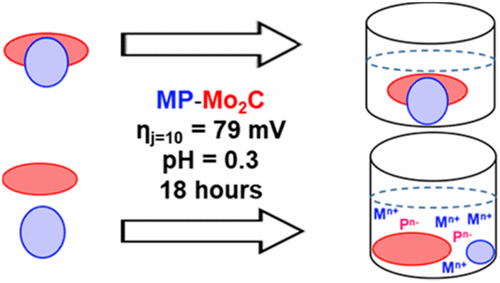当前位置:
X-MOL 学术
›
Chem. Mater.
›
论文详情
Our official English website, www.x-mol.net, welcomes your feedback! (Note: you will need to create a separate account there.)
Lattice Matched Carbide–Phosphide Composites with Superior Electrocatalytic Activity and Stability
Chemistry of Materials ( IF 8.6 ) Pub Date : 2017-10-31 00:00:00 , DOI: 10.1021/acs.chemmater.7b03377 Yagya N. Regmi 1 , Asa Roy 2, 3 , Laurie A. King 4 , David A. Cullen 5 , Harry M. Meyer 5 , Gabriel A. Goenaga 6 , Thomas A. Zawodzinski 2, 3, 6 , Nicole Labbé 1 , Stephen C. Chmely 1
Chemistry of Materials ( IF 8.6 ) Pub Date : 2017-10-31 00:00:00 , DOI: 10.1021/acs.chemmater.7b03377 Yagya N. Regmi 1 , Asa Roy 2, 3 , Laurie A. King 4 , David A. Cullen 5 , Harry M. Meyer 5 , Gabriel A. Goenaga 6 , Thomas A. Zawodzinski 2, 3, 6 , Nicole Labbé 1 , Stephen C. Chmely 1
Affiliation

|
Composites of electrocatalytically active transition-metal compounds present an intriguing opportunity toward enhanced activity and stability. To identify potentially scalable pairs of a catalytically active family of compounds, we demonstrate that phosphides of iron, nickel, and cobalt can be deposited on molybdenum carbide to generate nanocrystalline heterostructures. Composites synthesized via solvothermal decomposition of metal acetylacetonate salts in the presence of highly dispersed carbide nanoparticles show hydrogen evolution activities comparable to those of state-of-the-art non-noble metal catalysts. Investigation of the spent catalyst using high resolution microscopy and elemental analysis reveals that formation of carbide–phosphide composite prevents catalyst dissolution in acid electrolyte. Lattice mismatch between the two constituent electrocatalysts can be used to rationally improve electrochemical stability. Among the composites of iron, nickel, and cobalt phosphide, iron phosphide displays the lowest degree of lattice mismatch with molybdenum carbide and shows optimal electrochemical stability. Turnover rates of the composites are higher than that of the carbide substrate and compare favorably to other electrocatalysts based on earth-abundant elements. Our findings will inspire further investigation into composite nanocrystalline electrocatalysts that use molybdenum carbide as a stable catalyst support.
中文翻译:

具有优异电催化活性和稳定性的晶格匹配碳化物-磷化物复合材料
电催化活性过渡金属化合物的复合物为提高活性和稳定性提供了一个诱人的机会。为了确定潜在的可扩展的成对催化活性化合物对,我们证明了铁,镍和钴的磷化物可以沉积在碳化钼上以生成纳米晶体异质结构。在高度分散的碳化物纳米粒子的存在下,通过金属乙酰丙酮盐的溶剂热分解合成的复合材料显示出与现有非贵金属催化剂相当的析氢活性。使用高分辨率显微镜和元素分析对废催化剂进行的研究表明,碳化物-磷化物复合物的形成阻止了催化剂在酸性电解质中的溶解。两种组成的电催化剂之间的晶格失配可用于合理地改善电化学稳定性。在铁,镍和磷化钴的复合物中,磷化铁与碳化钼的晶格失配程度最低,并具有最佳的电化学稳定性。复合材料的周转率高于碳化物基体的周转率,并且与其他基于富含地球元素的电催化剂相比具有优势。我们的发现将激发对使用碳化钼作为稳定催化剂载体的复合纳米晶体电催化剂的进一步研究。磷化铁与碳化钼的晶格失配程度最低,并具有最佳的电化学稳定性。复合材料的周转率高于碳化物基体的周转率,并且与其他基于富含地球元素的电催化剂相比具有优势。我们的发现将激发对使用碳化钼作为稳定催化剂载体的复合纳米晶体电催化剂的进一步研究。磷化铁与碳化钼的晶格失配程度最低,并具有最佳的电化学稳定性。复合材料的周转率高于碳化物基体的周转率,并且与其他基于富含地球元素的电催化剂相比具有优势。我们的发现将激发对使用碳化钼作为稳定催化剂载体的复合纳米晶体电催化剂的进一步研究。
更新日期:2017-10-31
中文翻译:

具有优异电催化活性和稳定性的晶格匹配碳化物-磷化物复合材料
电催化活性过渡金属化合物的复合物为提高活性和稳定性提供了一个诱人的机会。为了确定潜在的可扩展的成对催化活性化合物对,我们证明了铁,镍和钴的磷化物可以沉积在碳化钼上以生成纳米晶体异质结构。在高度分散的碳化物纳米粒子的存在下,通过金属乙酰丙酮盐的溶剂热分解合成的复合材料显示出与现有非贵金属催化剂相当的析氢活性。使用高分辨率显微镜和元素分析对废催化剂进行的研究表明,碳化物-磷化物复合物的形成阻止了催化剂在酸性电解质中的溶解。两种组成的电催化剂之间的晶格失配可用于合理地改善电化学稳定性。在铁,镍和磷化钴的复合物中,磷化铁与碳化钼的晶格失配程度最低,并具有最佳的电化学稳定性。复合材料的周转率高于碳化物基体的周转率,并且与其他基于富含地球元素的电催化剂相比具有优势。我们的发现将激发对使用碳化钼作为稳定催化剂载体的复合纳米晶体电催化剂的进一步研究。磷化铁与碳化钼的晶格失配程度最低,并具有最佳的电化学稳定性。复合材料的周转率高于碳化物基体的周转率,并且与其他基于富含地球元素的电催化剂相比具有优势。我们的发现将激发对使用碳化钼作为稳定催化剂载体的复合纳米晶体电催化剂的进一步研究。磷化铁与碳化钼的晶格失配程度最低,并具有最佳的电化学稳定性。复合材料的周转率高于碳化物基体的周转率,并且与其他基于富含地球元素的电催化剂相比具有优势。我们的发现将激发对使用碳化钼作为稳定催化剂载体的复合纳米晶体电催化剂的进一步研究。



























 京公网安备 11010802027423号
京公网安备 11010802027423号